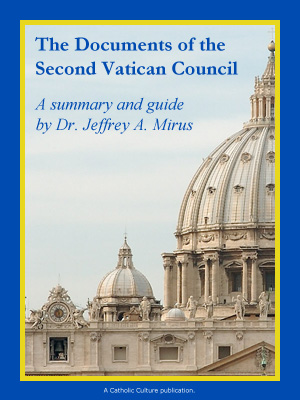Liturgical Renewal Today: A Quiet Emphasis on the Right Things
By Dr. Jeff Mirus ( bio - articles - email ) | Jan 08, 2014
To mark the 50th anniversary of Vatican II’s Constitution on the Sacred Liturgy (Sacrosanctum Concilium), the US Bishops’ Committee on Divine Worship issued a document called Stewards of the Tradition late last year. I was reminded of this when the text was published in the latest issue of Adoremus Bulletin. It is interesting to see what the bishops chose to emphasize fifty years after the Church officially committed itself to liturgical renewal.
The title “Stewards of the Tradition” is revealing. The document emphasizes first and foremost that the liturgy of the Church is the means by which the faithful are joined into one community and taken up into the mystery of salvation through the redemptive action of Jesus Christ in the Eucharist. It is important to recognize that this is what constitutes the great liturgical tradition of the Church, and not any particular rendering of the human linguistic and artistic elements. The whole point of the Council’s call for liturgical renewal was to refresh the “noble simplicity” characteristic of the Roman rite, so that the faithful could more fully recognize and participate in the sacred actions—an interior participation also manifested in various outward roles.
The document devotes its largest section to re-emphasizing what it sees as the foundational principles of the Council’s calls for renewal. These are listed below along with a brief illustration of what each means or how it has been achieved:
- The presence of Christ in the liturgy (The fundamental action of the liturgy is performed by Christ and that is the key to the liturgy; the priest acts in persona Christi.)
- Liturgical participation by the entire community (This has been enabled through a simpler form, the vocal participation of the congregation, and the incorporation of laity in specific roles.)
- Proclamation of the Word (Thus, what is now the Ordinary Form of the Roman Rite incorporates far more of Scripture throughout the year than had the previous form.)
- Inculturation of the liturgy (This has been achieved primarily by using the native languages of the faithful and drawing from a wider variety of musical forms and settings.)
In the section on “Liturgy as an Art and a Craft”, Stewards of the Tradition stresses several points made by Pope Benedict XVI in his Post-Synodal Exhortation Sacramentum Caritatis. The first and most important is the special responsibility of bishops, priests and deacons. These ordained ministers of the Church are stewards of the liturgy and must take great care in its celebration; they are not the masters of the liturgy, but Christ’s ministers in it. The text further draws inspiration from the ordination ceremony for the diaconate (the first step for all three ministerial ranks), in which “we first received the Book of the Gospels, being told to ‘believe what you read, teach what you believe, and practice what you teach’.” Catholic community has little meaning apart from this essential unity in Christian faith. (It is hard to miss the hint here that orthodoxy is integral to the liturgy, though it is expressed more deeply.)
Stewards of the Tradition is not a ground-breaking document; nor is it any sort of comeuppance for those guilty of liturgical abuses or false preaching. But, again, it is interesting and instructive to see what the Bishops’ Committee on Divine Worship has chosen to quietly emphasize as we gradually close the window on fifty years of turbulence—and, for a time, even abusiveness—in the wake of the Second Vatican Council’s call for an authentic renewal of the sacred liturgy of the Church of Christ.
All comments are moderated. To lighten our editing burden, only current donors are allowed to Sound Off. If you are a current donor, log in to see the comment form; otherwise please support our work, and Sound Off!
-
Posted by: John J Plick -
Jan. 08, 2014 10:56 PM ET USA
I would object to the definition that states:"...the liturgy of the Church is the means by which the faithful are joined..." It is amazing to me that the action of the Holy Spirit is so grossly assumed in any action that occurs within Church. "The Liturgy" is not some magic incantation which unfailingly produces a positive effect regardless of circumstances. The heart must be properly disposed. It amazes me that the rubrics of our Church are so often presented in a vacuum ignoring relationship.
-
Posted by: Randal Mandock -
Jan. 08, 2014 7:10 PM ET USA
I was raised on the pre-Vatican II liturgy. I remember a lot of participation by the laity then: vocal praying, vocally responding in our specific roles, on our knees, on our feet, on our seats, on our knees... Last Sunday I was marvelling that one could hear a pin drop during the praying of the Secret at Mass. Silence of that variety is not accidental. It is deliberate. This silence generates an electricity among those who are fully participating in the Mass. Chiun remarked: "Blessed silence."









